South Africa – Cape Province 2024
Mark Finn
March 9-23
This was our first revisit to the Western and Eastern Cape Provinces after a gap of several years. The birding was good throughout the area plus the pelagic off Simons Town despite the lack of any trawlers. It was interesting to note the demise of several species and the extended range of birds from further east. The following diary and bird lists should bring back many of the excellent sightings we made as a group in good company. In another email I have forwarded the pelagic highlights with images and approximate numbers of seabirds observed.
March 9th: Table Mountain, Kirstenbosch Botanical Gardens
Daily 39 New 39 Running 39
Weather: Warm and sunny with light SW winds 19c-26c
As all the group had arrived early into South Africa I started the tour a day earlier. Our first birding stop was to join the hordes of other tourists in taking the cable-car up Table Mountain which sits at over 3000 feet. Around hotel car park The scrub large numbers of Barn Swallows waiting to make the northward migration to Europe. The scrub and boulder strewn habitat at the cable-car departure point had Red-winged Starling, Familiar Chat, Southern Fiscal and Cape Robin Chat. Overhead a bonus was a hunting Rufous-breasted Sparrowhawk chasing the local Rock Martins and Little Swifts. As we boarded the cable-car we added Cape Sugarbird and Rock Kestrel. A walk on the trails revealed Cape Siskin and White-necked Ravens. The afternoon was spent wandering around the botanical gardens at Kirstenbosch a delightful area under the shadow of Table Mountain. On arrival the sky had African Goshawk, African Black Swift among many hirundines. The first patch of habitat we visited held Karoo Prinia, Southern Double Collared Sunbird and Swee Waxbill. Near the exhibition hut the first African Olive Pigeon, Hadada Ibis, Helmeted Guineafowl and a pair of Cape Batis. A walk along a quiet path with a running stream had a calling Knysna Warbler one of the most skulking species in Africa. In a dead tree a pair of Forest Siskins and an African Dusky Flycatcher. On the canopy walkway we watched a Fiscal Flycatcher and on the lawns several Egyptian Geese. The finale was two Olive Thrushes feeding on a lawn.
Mammals: Rock Hyrax (2)
March 10th: Paarl including the water treatment works and flower meadow
Daily 69 New 47 Running 85
Weather: Warm and sunny with SE winds 26c-32c
Due to an international cycling race in Cape Town I had to rejiggle the itinerary with a visit to Paarl. The lagoons are much reduced in size and now comprise of just two areas. On arrival we went through the gate and security to the first lagoon where we encountered Grey-headed and Hartlaub’s Gulls, African Spoonbill, Glossy, African Sacred and Hadada Ibis, Black-winged Stilt, Three-banded Plover, White-winged Tern, Malachite and Pied Kingfishers, Red-eyed, Ring-necked and Namaqua Doves, Red-billed and Hottentot Teals, Common Moorhen and Red-knobbed Coot. In the reeds we quickly located African Reed and Little Rush Warblers, Yellow Bishop and Levaillant’s Cisticola. From the elevated hide the group added White-breasted and Reed Cormorants, the uncommon White-backed Duck, Cape Shoveler, Yellow-billed Duck, White-faced Whistling Ducks, Common Moorhen, African Swamphen, Blacksmith Lapwing and overhead Brown-throated and Banded Martins, Greater Striped and White-throated Swallows. It was starting to get hot as we left the area and headed into the fynbos habitats of Jan Phillips road. It was good for sightings of Cape Sugarbird, Orange-breasted Sunbird, Cape Bulbul, Brimstone Canary and Karoo Scrub Robin. A return visit to the lagoons added little so we headed back to Cape Town and onto our base at Houlton Bay.
March 11th: Boulders Beach, Oliphantsbos, Cape of Good Hope
Daily 57 New 24 Running 109
Weather: Sunny with SE winds 18c-27c
From our base at Hout Bay I went along the scenic coast road to Simons Town which is the main base for the South African Navy. Our main birding today was at Boulders Beach with the entrance road gardens having the uncommon Dusky Sunbird and parties of Red-winged Starlings. On entering Boulders Beach we were entertained by close views of African Penguins either sitting on the beach or excavating new burrows. On offshore rocks the group located White-breasted, Cape and Crowned Cormorants, Crested Terns, Kelp and Hartlaub’s Gulls and African Sacred Ibis. The bushes of the reserve attracted Karoo Prinia and Cape White-eye. We visited Fishhoek for food supplies followed by a drive to the Cape of Good Hope Nature Reserve and Oliphantsbos. An initial exploration of the beach habitats added White-fronted, Common Ringed and Kittlitz’s Plovers, calling Eurasian Whimbrel, Sandwich Tern, and in bushes Cape Grassbird, Cape Canary, Speckled Mousebird, Malachite Sunbird and Plain-backed Pipits on the beach. The final stop at Cape of Good Hope had Common Ostrich by the roadside, Steppe Buzzard, Black-headed Heron and a showy Grey-backed Cisticola. At the end of the road lots of passing seabirds including Cape Gannets.
Mammals: Cape Fur Seal (20), Bontebok (12), Chacma Baboon (10), Reebok (2), Cape Mountain Zebra (1)
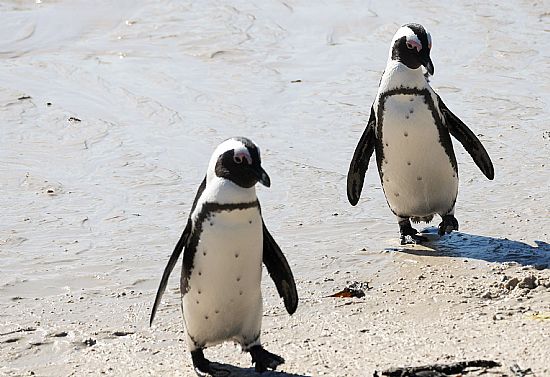
African Penguins
March 12th: Simons Town pelagic, Wildevoelvlei
Daily 63 New 22 Running 131
Weather: Warm and sunny with light SE winds 27c
We left the hotel at 0600 to make the journey to Simons Town the departure point for our pelagic trip south of Cape of Good Hope. Birds around the harbour included Red-winged Starling, Red-eyed Dove and Cape Cormorants perched on buoys. The first part of the pelagic trip was within False Bay with most of the birds being recorded beyond Cape Point. The first was Sooty Shearwaters which were joined a bit further out to sea by Great and Cory’s Shearwaters, White-chinned Petrels and Shy Albatrosses. Careful scanning of the waves revealed Wilson’s and European Storm Petrels. Other species present included Atlantic Yellow-nosed and Black-browed Albatrosses and pods of the attractive Dusky Dolphin. Due to the absence of trawlers and long-liners we headed back to Cape Point where we recorded African Penguin, African Black Oystercatcher, Crowned, White-breasted, Cape and Bank Cormorants and a few Sandwich Terns. An afternoon visit to the wetlands of Wildevoelvlei was planned although the access was a challenge. On arrival the lake held substantial numbers of Little Grebes plus a single Black-necked Grebe, Yellow-billed Duck, Common Moorhen, Red-knobbed Coot, African Swamphen and a Purple Heron. In the reedbeds we located Common Waxbill, Lesser Swamp Warbler, Cape Weaver and Levaillant’s Cisticola. In the scrubby areas our first sightings of Red-faced Mousebirds, Southern Fiscal, Southern Double-collared and Amethyst Sunbirds, Cape Sparrow and a male Pin-tailed Whydah.
Mammals: Dusky Dolphin (200), Cape Fur Seal (50), Humpback Whale (1), Bryde’s Whale (1)
March 13th: Rooi Els, Harold Porter Botanical Gardens
Daily 56 New 9 Running 140
Weather: Warm and sunny with SE winds 28c
Our travels today took us to the opposite side of False Bay and the village of Rooi Els. The commoner birds of Western Cape Province were seen along the way. The road towards Rooi Els was badly affected by rock slides and erosion which meant slow progress. On arrival a walk along the rocky road afforded us views of the fynbos and adjacent rocky habitats. It did not take too long to locate the resident Cape Rockjumpers with at least four birds being present. Careful scanning revealed sightings of African Black Swift, Rock Martin, Familiar Chat, Karoo Prinia, Southern Double-collared Sunbird, Cape Bunting and singing Cape Rock Thrushes. On the return walk a Rock Kestrel was seen hunting over the fynbos. Next on the agenda was the Harold Porter Botanical Gardens a well established area dating back several decades to the 1910’s. Before going to HPBG a group of Cape Spurfowl showed well in a garden. In the HPBG the car park had Brimstone Canary, African Dusky Flycatcher and Fiscal Flycatchers. A walk within the gardens was excellent for sightings with a stream having Cape White-eye, Cape Siskin and Cape Batis in attendance. Further along the path Streaky-headed Seedeaters and Cape Robin Chats were observed along with Olive Thrushes. The finale was to come along a quiet path with damp vegetation which attracted Victorin’s Warbler and Bar-throated Apalis two localised species of Southern Africa. The return walk was good for close views of Swee Waxbills and near the entrance gate a African Paradise Flycatcher.
Mammals: Klipspringer (2), Springbok (2)
March 14th: Strandfontein, Langebaan
Daily 77 New 15 Running 155
Weather: Sunny with cloudy spells on a SE wind 17c-24c
Checked out at Hout Bay and travelled the short distance to the extensive wetlands at Strandfontein. A tricky place to find and access with the first area suffering from drought, despite this the group added Great White Pelican, African Darter and Intermediate Egret to the list. The main birding area is nearby where the large lake near the entrance attracted Great Crested and Little Grebes, Reed and White-breasted Cormorants and Red-knobbed Coots. On the next lagoon literally hundreds of birds were present including Great Flamingo, Spur-winged and Egyptian Geese, Cape Shoveler, Red-billed and Yellow-billed Ducks, Cape Teal, Black-necked Grebe, African Swamphen and Common Moorhen. The next lagoon was shallower and held Blacksmith Lapwing, Black-winged Stilt, African Sacred, Glossy and Hadada Ibis and Black-headed Herons. At the last two lagoons we located good numbers of Pied Avocets and literally thousands of gulls including Kelp, Hartlaub’s and Grey-headed. On the return journey a single African Marsh Harrier hunting the reedbeds. After lunch we were on the road to the small town of Langebaan around 120km north of Cape Town. Along the way we had sightings of Common Ostrich, Black-winged Kite and Jackal Buzzard. On the coast we located Ruddy Turnstone, Pied Kingfisher, African Black Oystercatcher and literally thousands of Cape Cormorants. In the adjacent reeds and bushes Lesser Swamp and Little Rush Warblers and Yellow Canary were seen.
Mammals: Southern Oryx (20), Reebok (10), Giraffe (3)
March 15th: Langebaan, Seeberg, Geelbek, Tinie Versfeld
Daily 90 New 18 Running 173
Weather: Sunny with SE winds 27c
An enjoyable night was spent in Langebaan followed by picking up supplies and fueling the minibus. West Coast National Park is close by with the first stop being Seeberg which is excellent at high tide. On arrival there were thousands of birds present on the receding tide. Careful scanning of the flocks revealed the presence of Crested, Sandwich, Common, Little and a single Roseate Tern. The variety of waders was impressive with many showing signs of breeding plumage. The majority were feeding on the water edge and included Bar-tailed Godwit, Ruddy Turnstone, Little Stint, Curlew Sandpiper, Common Greenshank, Grey, Common Ringed, Kittlitz’s and White-fronted Plovers, African Black Oystercatcher, Whimbrel, Spotted Thick-knee, Greater and Lesser Flamingoes, White-breasted and Cape Cormorants. In the scrubby areas we had sightings of Cape Francolin, Karoo Scrub Robin and overhead Little Swifts. Our next stop was Geelbek where we walked down to one of the two hides. Similar birds to Seeberg with the addition of Pied Avocet and Common Greenshank. The trees held Cape Weaver and Southern Double Collared Sunbirds. After lunch a visit to one of the few freshwater ponds of the park added Little Grebe, Cape Teal, Yellow-billed Duck and African Black Crake to the list. On leaving the reserve we made a short journey to Tinie Versfeld which is a flower meadow on the southern spring. A walk towards the deserted buildings added Cape Longclaw, Southern Red Bishop and three Blue Cranes near farm buildings.
Mammals: Chacma Baboon (30), Eland (30), Giraffe (7), Bontebok (4)
March 16th: Tanqua Karoo
Daily 72 New 17 Running 190
Weather: Hot and sunny with light SE winds 30c
Today was spent birding in the wilderness and sparsely populated area of Tanqua Karoo. After passing Ceres where had hundreds of people queuing outside banks for cash. Our first birding stop at Tanqua Karoo was an area of reedbeds where we located Rufous-eared and Namaqua Warblers, White-throated Canary and Southern Fiscal. Further along the road a campsite was productive for the localised Fairy Flycatcher, Mountain Wheatear, Familiar Chat and Karoo Scrub Robin. The road goes through large areas of fynbos and another stop produced an adult Booted Eagle, Pale Chanting Goshawk, Large-billed Lark and Namaqua Dove. Lunch was taken under a rocky outcrop which had many Lark-like Buntings an irruptive species from further north. Also present were a party of Karoo Eremomela a truly scarce species plus Karoo Chat, Karoo Lark and a male Malachite Sunbird. Our final stop was at an old campsite dominated by cliffs and mature trees at the bottom of a valley. This had groups of Pale-winged Starlings and the uncommon Tractrac Chat. It was time to head back to base with stops at reservoirs and open country for birds. Nothing of note was seen after a great days birding in this remote area of South Africa.
Mammals: Klipspringer (3)
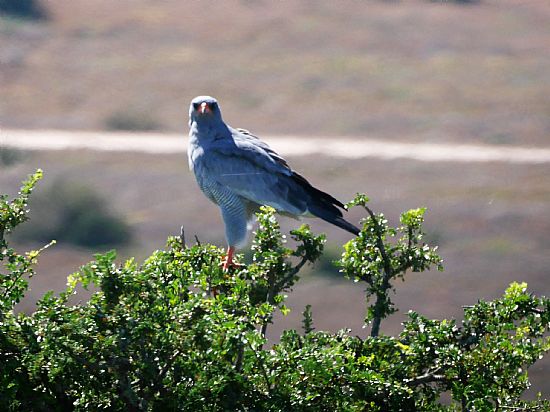
Pale Chanting Goshawk
March 17th: Dassiehoek, Vrolijheid, Knysna
Daily 59 New 5 Running 195
Weather: Warm and sunny with light S winds 28c
This morning was a travel day east towards the town of Knysna. I had intended to travel north but the logistics did not work so the group visited two areas near Worcester. A filling station added our first new bird in Pied Starling. Dassiehoek was reached with Steppe and Jackal Buzzards on the wires. Further up the valley our first sighting of African Fish Eagle. A small lake attracted the commoner ducks and Red-knobbed Coots. A walk up the valley was good for Olive Thrush, Speckled Mousebird, Sombre Greenbul and Greater Striped Swallows. After lunch we made a visit to Vrolijheid where the acacia trees held Chestnut-vented Tit Babbler and a pair of Bar-throated Apalis. The hide has views over a lagoon where African Snipe and Three-banded Plovers were seen. The remainder of the day was spent travelling to Knysna a small town on the coast.
Mammals: Springbok (1), Small Grey Mongoose (1)
March 18th: Knysna, Wilderness including Ebb and Flow and Big Tree
Daily 73 New 13 Running 208
Weather: Sunny and warm with SE winds 29c
Our hotel at Knysna is situated by the estuary and offers excellent birding. In the hotel grounds several Fork-tailed Drongo and Greater Double-collared Sunbirds. After breakfast I headed to Wilderness and the Ebb and Flow complex. A walk along the river was very productive for Knysna Turaco, Chorister Robin Chat, Olive Woodpecker, Green-backed Camaroptera, Cape Batis, African Paradise Flycatcher and Bar-throated Apalis. Further along the trail located a feeding flock with Blue-mantled Crested Flycatcher, Yellow-throated Woodland Warbler and a Narina Trogon. A slow drive along Lake Drive was productive for African Hoopoe, Fiscal Flycatcher and in the reedbed African Crake. Our final birding stop was at Woodville an area of mature forest. In the sky several Black Sawwing and Brown-hooded Kingfisher on the entrance track. A walk along the trails added Black-backed Puffback, Knysna Woodpecker and family parties of Cape Batis.
Mammals: Bushbuck (1)
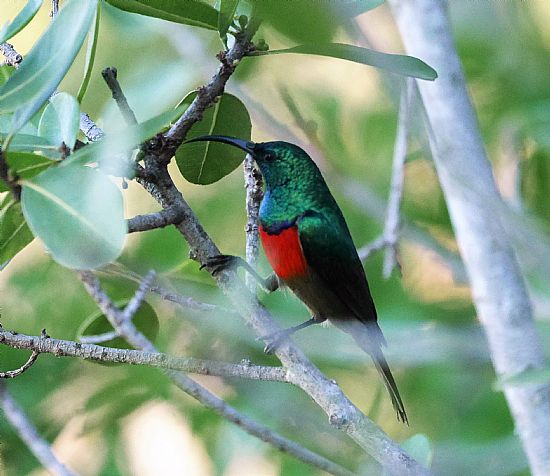
Greater Double-collared Sunbird
March 19th: Knysna, Ecoretreats, Protea Farm, Kaimaans River, Woodbourne
Daily 80 New 5 Running 213
Weather: Warm and sunny with light SE winds 19c-27c
Depart at 0600 hours to arrive at Ecoretreats. Here me met up with Tim Carr the owner who is slowly restoring the area. The walk along the path quickly revealed the presence of Bar-throated Apalis, Karoo Prinia, Cape Robin Chat and Brimstone Canary. A bare tree held Brimstone Canary and Streak-headed Seedeaters and the first Fork-tailed Drongos of the day. The area around Tim’s house was good for Knysna Woodpecker and Black-headed Oriole. A walk towards the lake added an African Hoopoe, and on the lake a selection of the common ducks. A bonus came when a summering Willow Warbler was observed gleaning insects from a leafy tree, the bird was most likely to be one of the High Arctic races. Our next birding stop was a protea farm where the bushes held at least three Knysna Turaco, Black-backed Puffback and a group of Pin-tailed Whydah. A Hamerkop flew over being the first record of the trip. Next was Kaimaans River where we located the localised Half-collared Kingfisher. I decided to return to Knysna and visit The Head and Woodbourne areas. The marsh held Red-billed and Yellow-billed Ducks, Cape Teal, Cape Shoveler, African Rail, Black Crake, African Snipe, Pied Avocet, Eurasian Whimbrel, Common Greenshank, Ringed Plover, Little Stint, Giant and Pied Kingfishers and a rather late Western Osprey.
Mammals: Small Grey Mongoose (1)
March 20th: Knysna, Gamtoos, Port Elizabeth
Daily 64 New 6 Running 219
Weather: Rather mixed with sunny spells and cloud. SE wind 17c-27c
The birds around the garden were similar to the last two days. At 0900 hours we left for the journey into the Eastern Cape and the major city of Port Elizabeth. On the entrance road to Gamtoos Jo located the first of six Denham’s Bustards walking around a field with water sprinklers. On a nearby hillside good views of a hunting Forest Buzzard. The road toward Gamtoos had several misleading signs which should be ignored as this is not a private road. Parked up by the reserve entrance where the group located African Black Oystercatcher, Kelp Gull, Grey and Ringed Plovers, Pied Kingfisher and Intermediate Egret. Overhead I was surprised to locate at least two Blue-cheeked Bee-eaters hawking for insects. A diversion towards a gated village was excellent for Denham’s Bustards with at least five birds being observed and a group of migrant Crowned Lapwings. I was time to travel to Port Elizabeth which is our final base in South Africa for three nights.
Mammals: Rock Hyrax (2)
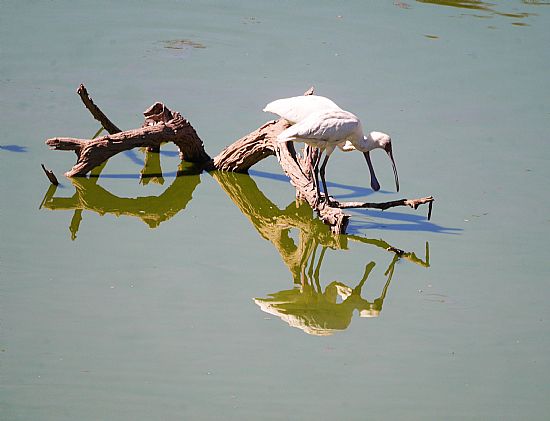
African Spoonbills
March 21st: Addo
Daily 61 New 9 Running 228
Weather: Hot and sunny with NE winds 39c
Today I decided to visit Addo and the reserve which is situated around 16km to the north. On arrival we purchased permits and then drove into the reserve itself. The first stop was productive for the secretive Southern Tchagra and African Pipits on the bare ground of the grasslands. A little further on an area of scrub attracted a pair of Chestnut-vented Tit Babblers and a single Brown Scrub Robin the latter being a scarce and secretive bird. Other species present included African Spoonbill, Yellow-billed Duck, Grey Heron and a family of Cape Crows. A slow drive along the track for views of Red-backed and Lesser Grey Shrikes, Pale Chanting Goshawk and in the more arid habitats Red-capped and Large-billed Larks and several Ant-eater Chats. Lunch was taken at Jacks Camp which was named after a famous Black Rhinoceros. By the picnic tables close views of Southern Boubou and Sombre Greenbuls. A slow drive towards the park entrance and a birding stop in the gardens. This was good for sightings of African Hoopoe, Cape and Red-winged Starlings and Streaky-headed Seedeaters.
Mammals: Small Grey Mongoose (4), Vervet Monkey (10), Warthog (20), Leopard (1), African Elephant (200), Meerkat (1), Khama Hartebeest (6)
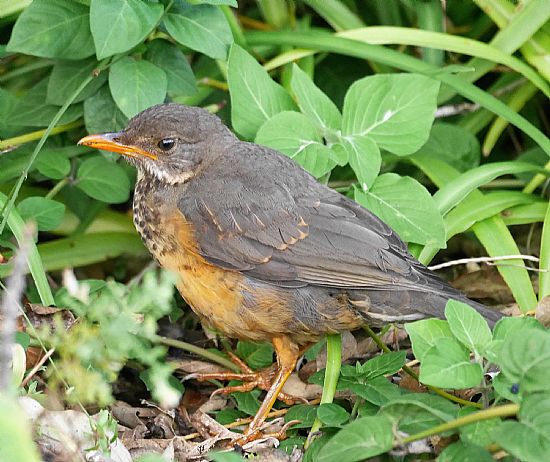
Olive Thrush
March 22nd: Port Elizabeth, Hankey including Yellowwoods, Krom Estuary, Cape Recife
Daily 86 New 6 Final 234
Weather: Hot and sunny inland, cooler on the coast with a SE wind 19c-31c
This morning I headed inland to the small town of Hankey and Yellowwoods Park. On arrival the area was full of birds and the group embarked on a walk among the large trees and adjacent stream. The grass areas held African Hoopoe, Olive Thrush and Swee Waxbill. In the reeds brief views of a Burchell’s Coucal. In the larger tree the group located African Dusky and Spotted Flycatchers, Streaky-headed Seedeater, Yellow-fronted and Yellow Canaries, Cape Batis and Bar-throated Apalis. On the way to the Krom Estuary which is a playground of the rich and wealthy of South African society. On the way we located Crowned Lapwing and Jackal Buzzard. At the Krom Estuary after a little bit of searching a view point was found in the housing complex. A scan of the river and extensive sand bars revealed Sandwich, Common and Little Terns, Grey and White-fronted Plovers, Little Stint, Curlew Sandpiper and Sanderling. In the area a surprise find was Lillian’s Lovebird which must be an escape as the nearest populations are in Zimbabwe. The final stop of the tour was at Cape Recife a windswept cape exposed to the winds and storms of the Indian Ocean. On arrival the shore held Kelp and Hartlaub’s Gulls, African Black Oystercatchers and on offshore rocks three species of cormorants. Cape Gannet, Crested and Sandwich Terns were passing close to the cape and battling the strong winds. I decided to visit the hide near the reclamation works which was poorly signed, the lagoon was largely devoid of bird life except for Three-banded Plovers. On the return walk Black-collared Barbets were seen and this was the last new bird of the trip.
Mammals: Springbok (100+)

Cape Town Pelagics – tour report

